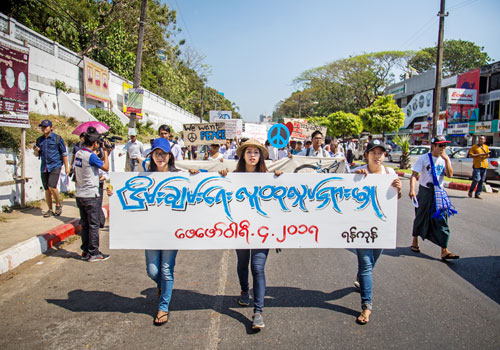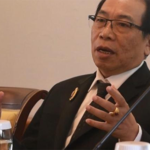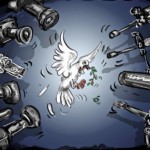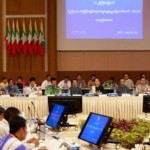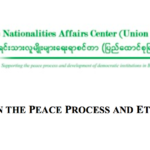By Lun Min Mang / Myanmar Times | February 6, 2017
Thousands of protesters, civil society organisations and rights advocates took to the streets over the weekend at several major cities around the country in calls for peace ahead of the Panglong Peace Conference due to be held later this month.
The demonstrations were held simultaneously on February 4 in different locations including in Nattalin township in Bago, Shwebo township in Sagaing and Pulaw in Tanintharyi regions and in Kayah State.
In Yangon, hundreds of residents gathered in two groups – at Myaynigone in Sanchaung township and at the Bo Sein Hman playground in Bahan township – before marching to City Hall.
Along the way, the demonstrators called for an “end to fighting”, “free flow of aid to IDP
The 21st Century Panglong Conference is due to be held later this month in Nay Pyi Taw – the date has yet to be announced – where officials representing the government, political parties, civil society organisations and armed organisations who signed the Nationwide Ceasefire Agreement (NCA) are to meet yet again to work out a peace plan for the nation.
The first session of the conference took place at the end of August 2016 after the ruling NLD party took office in April.
However, fighting in the northern Shan State, including the Kokang’s self-autonomous area, has continued between government’s troops and members of the Northern Alliance, an armed coalition of four non-signatory groups to the NCA.
U Myat Kyaw, one of the protest leaders on Saturday, said changing the 2008 Constitution lies at the heart of the peace process.
“Unless we amend the 2008 constitution, we cannot have genuine peace in our country.
“We hope that leaders from both sides can have something concrete from the peace negotiations,” he said.
On the first anniversary of the NCA on October 15, 2016, State Counsellor Daw Aung San Suu Kyi, who also chairs the National Reconciliation and Peace Centre as well as the Union Peace and Dialogue Joint Committee, announced her seven-step peace policy.
Amending the 2008 charter, based on the results of political dialogues, was one of the seven steps.
U Han Sein, 71, an Insein resident and a member of the ruling-NLD party who participated in the protests on February 4, said the internal conflicts of Myanmar began when he was young, and he wished for peace to be a reality during his lifetime.
“We should have metta [goodwill] to each other. If our country’s leaders cooperate well in achieving peace, then I don’t think it is hard to obtain reconciliation and peace in our country,” he said.
As they marched towards City Hall, protest organisers said they did not encounter problems with the security forces. After reaching Mahabandoola Park in front of City Hall, protest leaders delivered their speeches. Pan Yet Lan, a non-profit music band, played songs calling for peace.
In his speech, human rights and peace advocate U Aung Myo Min suggested that military expenditure be reduced and channelled to other necessary areas in Myanmar’s impoverished communities and societies.
“Instead of expanding military expenditure, public money should be used for education, health, social welfare and rule of law for public safety. It is for the good of people not just in urban, but also in rural areas,” he said.
Citing Daw Aung San Suu Kyi when she met with youth representatives to discuss peace in early January this year, U Aung Myo Min said the call for peace should be louder so that “people with the tendency to be deaf” could hear.
“We make consistent calls for peace. We want to stop internal fighting. We always hope for peace. Like my colleagues said, there are people who tend to be deaf and not hear our call for peace. At the same time, there are also selfish people who are not committed to stopping the war.
“We want war to be removed from our country. We want to put them in museums,” U Aung Myo Min added.
Ma Esther, an ethnic Kachin peace advocate, said ethnic people who are displaced by the ongoing fighting are now in dire straits in Kachin and Shan states. She said the number of IDPs in the two conflict-torn states and Rakhine State totals more than 500,000.
“The most responsible ministry for IDPs is the Ministry of Social Welfare. But, so far, we know that they do not have a specific plan for IDPs,” she said.
Although eight armed groups have signed the NCA with the previous government in October 2015, major groups that are currently engaged in military hostilities with the Tatmadaw have not signed it. The NLD government is negotiating to bring them on board.
Ko Min Thway Thit, a student representative involved in the protest, said Myanmar is like a family where members fight one another.
“While other countries have become developed nations, we are still having internal fighting among us. We are lucky that we’ve still got some young and adult people who really want peace for our nation,” he said.
As preparations are underway for the second session of the 21st Century Panglong Conference, 52-year old Dawbon resident and protester U Tin Htoo said he believes achieving internal peace is not impossible.
“I think if the rest of the armed ethnic groups have a chance to sign the Nationwide Ceasefire Agreement, then we would have the internal conflict solved. We want that peace and reconciliation,” he said.
This article originally appeared on Myanmar Times on February 6, 2017.

